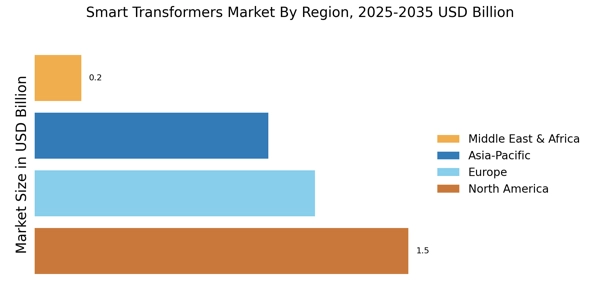Supportive Government Policies
Supportive government policies play a crucial role in driving the Smart Transformers Market. Many countries are implementing regulations and incentives aimed at promoting the adoption of smart grid technologies and renewable energy sources. For instance, various governments have established funding programs to support the deployment of smart transformers, which are essential for integrating renewable energy into existing grids. The International Energy Agency has reported that investments in smart grid technologies could reach over 300 billion USD by 2030, highlighting the potential for growth in the Smart Transformers Market. These policies not only encourage innovation but also create a favorable environment for manufacturers and utilities to invest in smart transformer solutions.
Rising Demand for Energy Efficiency
The rising demand for energy efficiency is a significant driver for the Smart Transformers Market. As energy costs continue to escalate, both consumers and industries are seeking solutions that minimize energy consumption. Smart transformers, with their advanced monitoring and control capabilities, enable more efficient energy distribution and usage. According to recent estimates, energy efficiency measures could reduce global energy consumption by up to 30% by 2030. This potential reduction underscores the importance of smart transformers in achieving energy efficiency goals. Additionally, as governments and organizations prioritize sustainability, the Smart Transformers Market is likely to experience increased investment and innovation, further enhancing the role of smart transformers in energy management.
Growing Investment in Renewable Energy
Growing investment in renewable energy is a key driver for the Smart Transformers Market. As countries strive to meet their renewable energy targets, the need for efficient energy management solutions becomes paramount. Smart transformers are essential for integrating renewable energy sources such as solar and wind into the grid, ensuring stability and reliability. Recent reports indicate that global investments in renewable energy are expected to exceed 2 trillion USD by 2030, which will likely boost the demand for smart transformers. This trend not only supports the transition to cleaner energy but also enhances the resilience of energy systems, positioning the Smart Transformers Market for substantial growth in the coming years.
Integration of Smart Grid Technologies
The integration of smart grid technologies is a pivotal driver for the Smart Transformers Market. Smart transformers facilitate real-time data exchange and enhance grid reliability, which is increasingly essential as energy demands rise. The Smart Transformers Market is projected to reach approximately 100 billion USD by 2025, indicating a robust growth trajectory. This integration allows for improved energy management and distribution efficiency, which is crucial for accommodating renewable energy sources. As utilities invest in modernizing their infrastructure, the demand for smart transformers is likely to surge, thereby propelling the Smart Transformers Market forward. Furthermore, the ability of smart transformers to support demand response programs and energy storage solutions positions them as integral components in the evolving energy landscape.
Technological Advancements in Transformer Design
Technological advancements in transformer design are significantly influencing the Smart Transformers Market. Innovations such as the development of solid-state transformers and enhanced insulation materials are improving the performance and reliability of smart transformers. These advancements allow for higher efficiency, reduced losses, and better integration with renewable energy sources. The market for smart transformers is expected to grow at a compound annual growth rate of around 20% over the next few years, driven by these technological improvements. As manufacturers continue to innovate, the Smart Transformers Market is likely to see a proliferation of advanced products that meet the evolving needs of energy systems.


















Leave a Comment